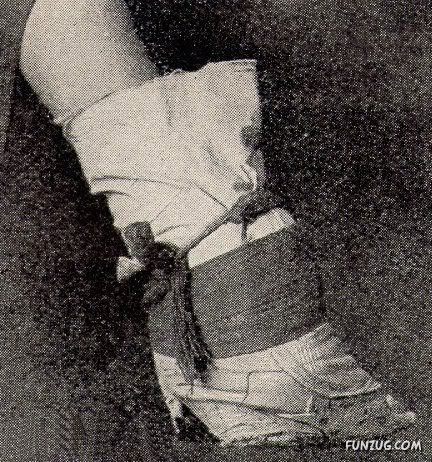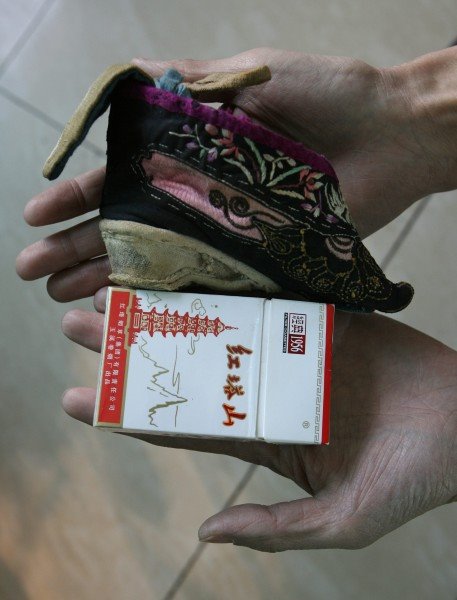


The process was started before the arch of the foot had a chance to develop fully, usually between the ages of three and fourteen. Binding usually started during the winter months so that the feet were numb, meaning the pain would not be as extreme.
- First, each foot would be soaked in a warm mixture of herbs and animal blood; this was intended to soften the foot and aid the binding. Then, the toenails were cut back as far as possible to prevent in-growth and subsequent infections, since the toes were to be pressed tightly into the sole of the foot. To prepare her for what was to come next, the girl's feet were delicately massaged. Cotton bandages, 3 m long and 5 cm wide (10 ft×2 in), were prepared by soaking them in the blood and herb mixture. To enable the size of the feet to be reduced, the toes on each foot were curled under, then pressed with great force downwards and squeezed into the sole of the foot until the toes break. This was all carried out with no pain relief, causing the girl to experience severe pain. The broken toes were then held tightly against the sole of the foot. The foot was then drawn down straight with the leg and the arch forcibly broken. The actual binding of the feet was then begun. The bandages were repeatedly wound in a figure-eight movement, starting at the inside of the foot at the instep, then carried over the toes, under the foot, and round the heel, the freshly broken toes being pressed tightly into the sole of the foot. At each pass around the foot, the binding cloth was tightened, pulling the ball of the foot and the heel ever close together, causing the broken foot to fold at the arch, and pressing the toes underneath, this would cause the young girl excruciating pain. When the binding was completed, the end of the binding cloth was sewn tightly to prevent the girl from loosening it, and the girl was required to stand on her freshly broken & bound feet to further crush them into shape. As the wet bandages dried, they constricted, making the binding even tighter.

- The girl's broken feet required a great deal of care and attention, and they would be unbound regularly. Each time the feet were unbound, they were washed, the toes carefully checked for injury, and the nails carefully and meticulously trimmed. When unbound, the broken feet were also kneaded to soften them and make the joints and broken bones more flexible, and were soaked in a concoction that caused any necrotic flesh to fall off.
Immediately after this pedicure, the girl's broken toes were folded back under and the feet were rebound. The bindings were pulled ever tighter each time, so that the process became more and more painful. Whilst unbound, the girl's feet were often beaten, especially on the soles, to ensure that her feet remained broken and flexible. This unbinding and rebinding ritual was repeated as often as possible (for the rich at least once daily, for poor peasants two or three times a week), with fresh bindings. It was generally an elder female member of the girl's family or a professional foot binder who carried out the initial breaking and ongoing binding of the feet. This was considered preferable to having the mother do it, as she might have been sympathetic to her daughter's pain and less willing to keep the bindings tight. A professional foot binder would ignore the girl's cries and would continue to bind her feet as tightly as possible. Professional foot binders would also tend to be more extreme in the initial breaking of the feet, sometimes breaking each of the toes in two or three separate places, and even completely dislocating the toes to allow them to be pressed under and bound more tightly. This would cause the girl to suffer from devastating foot pain, but her feet were more likely to achieve the 7 cm (3 in) ideal. The girl was not allowed to rest after her feet had been bound; however much pain she was suffering, she was required to walk on her broken and bound feet, so that her own body weight would help press and crush her feet into the desired shape.
- The most common problem with bound feet was infection. Despite the amount of care taken in regularly trimming the toenails, they would often in-grow, becoming infected and causing injuries to the toes. Sometimes for this reason the girl's toenails would be peeled back and removed altogether. The tightness of the binding meant that the circulation in the feet was faulty, and the circulation to the toes was almost cut off, so any injuries to the toes were unlikely to heal and were likely to gradually worsen and lead to infected toes and rotting flesh. If the infection in the feet and toes entered the bones, it could cause them to soften, which could result in toes dropping off—though this was seen as a positive, as the feet could then be bound even more tightly. Girls whose toes were more fleshy would sometimes have shards of glass or pieces of broken tiles inserted within the binding next to her feet and between her toes to cause injury and introduce infection deliberately. Disease inevitably followed infection, meaning that death from septic shock could result from foot-binding, but a surviving girl was more at risk for medical problems as she grew older. In the early part of the binding, many of the foot bones would remain broken, often for years. However, as the girl grew older, the bones would begin to heal, although even after the foot bones had healed they were prone to re-breaking repeatedly, especially when the girl was in her teens and her feet were still soft. Older women were more likely to break hips and other bones in falls, since they could not balance securely on their feet, and were less able to rise to their feet from a sitting position. Since the women in China weren't able to walk properly anymore, most had to have servants do most of the cleaning, cooking, and caring of children and husband.
Women with such deformed feet avoided placing weight on the front of the foot and tended to walk predominantly on their heels. As a result, women who underwent foot-binding walked in a careful, cautious, and unsteady manner. The very fact that the bound foot was concealed from men's eyes was, in and of itself, sexually appealing.

Another attribute of a woman with bound feet was the limitations of her mobility and, therefore, her inability to take part in politics, social life, and the world at large. Bound feet rendered women dependent on their families, particularly their men, and, therefore, became an alluring symbol of chastity and male ownership, since a woman was largely restricted to her home and could not venture far without an escort or the help of watchful servants.

5 comments:
i heard stories about this when i was little... but its the first time i'm seeing the real thing! this is just not cool... makes me sad when i look at these pictures =(
Yes, I agree with you. People in those days were so cruel to women and their thinking were seriously distorted until they thought the act of maiming a woman's feet eternally was a symbol of beauty and chastity.
that's so sick. OUCH!!
I am writing an essay on foot bounding and this blog was really helpful thanks!:)
ft
Post a Comment